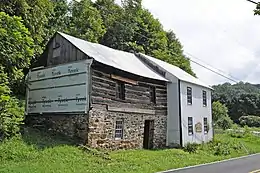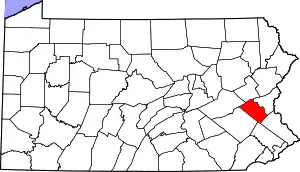Zionsville, Pennsylvania
Zionsville is a village mostly in Upper Milford Township, Lehigh County, and also in Lower Milford Township, Lehigh County, Pennsylvania, United States. Its ZIP code is 18092. The West Branch Hosensack Creek forms its natural SE boundary and drains it via the Hosensack Creek to the Perkiomen Creek.
Zionsville, Pennsylvania | |
|---|---|
Unincorporated community | |
 Zionsville  Zionsville | |
| Coordinates: 40°28′47″N 75°30′19″W | |
| Country | United States |
| State | Pennsylvania |
| County | Lehigh |
| Townships | Upper Milford, Lower Milford |
| Elevation | 600 ft (200 m) |
| Population | |
| • Total | 3,192 |
| • Density | 208/sq mi (80/km2) |
| Time zone | UTC-5 (Eastern (EST)) |
| • Summer (DST) | UTC-4 (EDT) |
| ZIP code | 18092 |
| Area code(s) | 610 & 484 |
History
The area of modern day Zionsville was once inhabited by the Lenni Lenape tribe and lived on for almost 10,000 years.[1] The Lenape tribes were known to live along river fronts or creeks and using the fertile land around these areas for farming purposes. Due to the overwhelming harvesting and planting of the land, it degraded its quality and eventually could no longer sustain crop, leading to the land becoming uninhabitable and the tribes slowly left the area. In the 17th century, Dutch colonists arrived into the area and began buying animal pelts from the Lenape in exchange for European products. In 1682, William Penn and Quaker colonists arrived and founded the Pennsylvania Colony in the lower Delaware River. A peace treaty was signed with the newly arriving English and Lenape tribes, however in the decades building up an estimated 20,000 colonists arrived in the area forcing the Lenape to keep up with the colonists. The colony displaced many Lenape people and others were forced to assimilate. [2]
William Penn then died in 1718, his two remaining sons, John and Thomas Penn, along with the leaders running the colony, stopped practicing of William Penn's policies. Attempting to gain more money, they began considering selling land belonging to the Lenape in a agreement with the Penn family now known as the Walking Purchase. The Lenape were displaced from their land and as a result began raiding Pennsylvanian settlements. In 1788, most of the lasting Lenape were no longer living in the Pennsylvania region and began settling in the Ohio region.[3][4]
Old Zionsville was founded in 1734 by a group of German settlers on Kings Hwy Rd, building multiple churches in the region with the oldest being a log cabin built in 1740 which is no longer standing.[5] [6]
Modern day Zionsville was originally a part of Old Zionsville, it stayed this way up until 1876 when the Perkiomen Railroad was constructed around one mile southeast of Old Zionsville, leading to the founding of "Zionsville Station". Then the name changed to "New Zionsville", then it underwent its final name change to Zionsville, the old Zionsville then being named Old Zionsville.[7]
Demographics
As of the 2010 census, the population of the 18092 zip code was 3,223. 97.1% of the population is white, 0.3% is black, 0.2% is Native American, and 1.1% is Asian.[8] The zip code is in Upper and Lower Milford Townships and to a very small extent in Hereford Township, Berks County.
Education

Zionsville is part of the East Penn School District. Students in grades 9-12 attend Emmaus High School. Students in grades six through eight attend either Eyer Middle School or Lower Macungie Middle School. Towards the end of the village in Lower Milford, students attend Southern Lehigh School District.
Students in grades 9-12 attend Southern Lehigh High School. It is also home to the historic Dillingersville Union School and Church, first built in 1735.[9]
Industry
The Lehigh Crane Iron Company once maintained a hematite mine in Zionsville, which was served by the north-to-south Perkiomen Branch of the Reading Railroad. This line remains active north from Pennsburg to Emmaus as a branch of the East Penn Railroad.
Post office closure
In January 2009, the Zionsville Post Office closed after the owners of the building in which the U.S. Postal Service was located refused to renew the lease. It served portions of Upper Milford, Lower Milford, and Hereford Townships, including the villages of Corning, Dillingersville, Hosensack, Powder Valley, Sigmund, and some Five Points, Berks County residents.
The residents of the ZIP code 18092 have since been served by the Hereford Post Office, but allowed to maintain the use of "Zionsville, PA 18092" as a legal part of their addresses. Zionsville PO Box customers have been hosted by the Old Zionsville Post Office while packages and certified mail that have to be signed for must be picked up in Hereford.[10][11]
Notes
- "lenni-Lenape". tadubois.com. Retrieved 2021-02-06.
- O', James; Spady, Neil. ""Colonialism and the Discursive Antecedents of Penn's Treaty with the Indians," in William A. Pencak and Daniel K. Richter, eds., From Native America to Penn's Woods: Colonists, Indians, and the Racial Construction of Pennsylvania (State College: Pennsylvania State University Press, 2004), 18-40". Cite journal requires
|journal=(help) - Encyclopedia of American Indian Wars. 1999.
- Harper, Steven Craig (2006). Promised Land: Penn's Holy Experiment, the Walking Purchase, and the dispossession of Delawares. Bethlehem, PA: Steve Craig Harper.
- "The History of Upper Milford – Lehigh Valley History". Retrieved 2021-02-06.
- "Old Zionsville: Our History". Retrieved 2021-02-06.
- "Upper Milford Historical Society Puts Things in Perspective". Emmaus, PA Patch. 2011-03-13. Retrieved 2021-02-06.
- "Profile of General Demographics and Housing Characteristics: 2010". American FactFinder. United States Census Bureau. Archived from the original on February 12, 2020. Retrieved December 6, 2013.
- "History of the Dillingersville School Union School and Church Association". Dillingersville School Union School and Church Association. Retrieved December 6, 2013.
- Lester, Patrick (January 21, 2009). "Zionsville Post Office closing its doors". The Morning Call. Retrieved December 6, 2013.
- Lester, Patrick (October 8, 2010). "Residents want to keep addresses". The Morning Call. Retrieved December 6, 2013.
